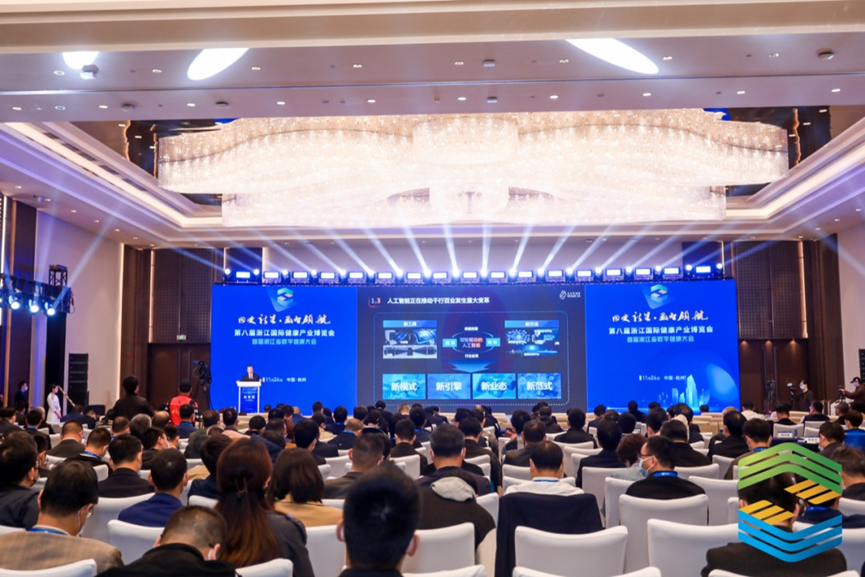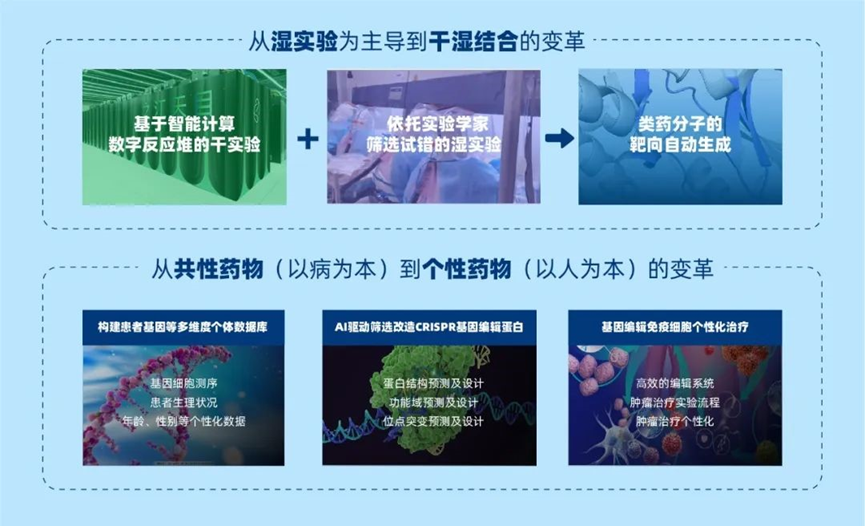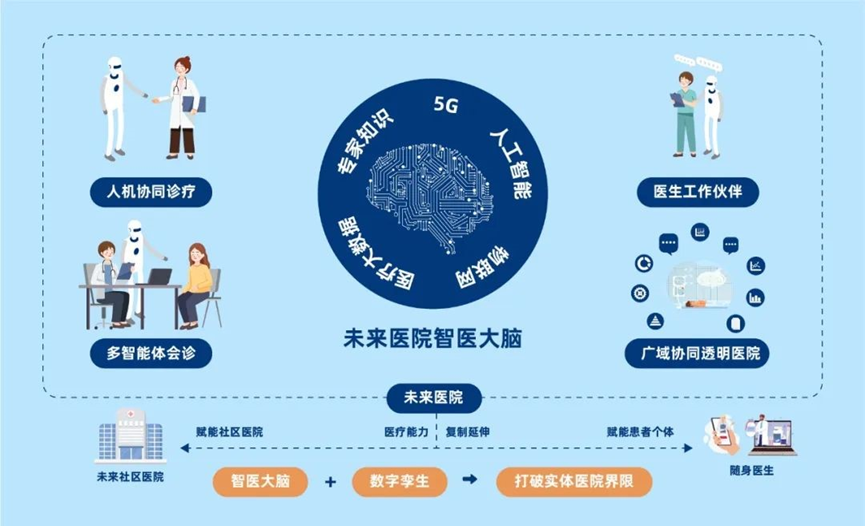

"In the age of digital civilization, intellectualization is a certain trend for the development of healthcare in the future." At the first Zhejiang Digital Health Conference held recently, Professor ZHU Shiqiang, President of Zhejiang Lab gave an excellent report on the intelligent changes of healthcare industry promoted by AI.

Professor ZHU pointed out that with the support of big data and AI technology, six major changes will take place in the area of healthcare, i.e., the changes in medical testing method, medical diagnosis method, medicine R&D pattern, hospital management method, government regulatory model and social medical concept.
First, medical testing method
"With the development of multi-modal medical imaging intelligent technology and the intelligent real-time dynamic monitoring system of health data, medical testing equipment will be transformed from outputting data to directly outputting results." ZHU Shiqiang said that, based on the assistant diagnosis equipment integrating multi-modal sensory information integration and perception, we are able to precisely locate the lesion, conduct quick pathologic analysis and realize accurate diagnosis. Relying on the highly-sensitive and wearable/implantable equipment that's able to constantly perceive dynamic physiological indicators, we can establish the integrated system on cloud for real-time monitoring, diagnosis and alarm of health signs so as to know precisely the health conditions of an individual.
Zhejiang Lab is currently developing the multi-modal medical perception assistant diagnosis equipment which will integrate and expand optical imaging, ultrasonic imaging, X-ray imaging and other traditional medical imaging means. The intelligent perception diagnosis and treatment system based on AI technology is also under development. Relying on electronic endoscope to provide 3D shapes of intra-cavity tissues and cells, photo-acoustic imaging to obtain the structure and functions of deep-layer tissue painlessly, rapid pathologic testing to realize timely analysis of tissue sections and other technologies, we can achieve efficient collection and targeted processing and integration of cross-scale multi-modal information so as to provide doctors with complete diagnostic basis. Many of these technologies have formed prototypes and been verified in clinical usage.
Second, medical diagnosis method
With deepened development of AI technology, the diagnosis method of illness has been changed from people-oriented to "man-machine collaboration". Knowledge graph and other technology and assistant decision-making tools will be of great help for clinical diagnosis.
"It took us about 2 years to sort out the medical data of several large hospitals and formulate the knowledge graph of electronic medical history of super large scale. Using the knowledge graph, we can explore the information of illness hidden in massive medical data for comprehensive cross-diagnosis and treatment." said ZHU.
Based on the knowledge graph, the scientific research team of Zhejiang Lab deduced and discovered 71,679 patients with hidden risks of chronic nephrosis from the medical treatment data of non-kidney department(s) of certain Grade A Tertiary Hospital from 2007 to 2019. Follow-up visits of 5,439 patients from June to December 2019 show that 82.1% of the high-risk patients were diagnosed with chronic nephrosis. It indicates that the knowledge graph can give an early warning of chronic nephrosis risks about 2 years in advance.
Third, medicine R&D pattern
The change in medical R&D pattern can be divided into two levels. First, from wet experiment to integrated dry and wet experiment. "Relying on AI algorithms, we can analyze molecular interactions in details, and figure out the signal channel of illness in human body so as to locate the protein target for effective intervention. Based on the target, we can generate lots of drug-like molecules for the reference of pharmacologist." said ZHU.
Relying on the major scientific and technological infrastructure of intelligent computing data reactor, Zhejiang Lab builds the intelligent computing pharmaceutical open platform to empower medicine R&D by intelligent computing. The drug-like molecules generated by automatic targets alleviates the risks and costs of traditional selection and trial processes and greatly improves the efficiency in medicine R&D.
Second, from generic medicine to personalized medicine. AI technology makes personalized medicine possible. For example, the immune cell treatment based on AI and CRISPR gene editing is able to intelligently analyze the personalized data of cancer patients including their genes, sex, age and physiological conditions and realize personalized treatment by editing the genes of the patients' immune cells, which helps improve the life cycle of cancer patients.

Fourth, hospital management method
The change in management method brought by AI technology can be summarized in two aspects. Within the hospital, the expanding adoption of AI technology makes the internal management more transparent, open and intelligent; and from the perspective of patient management, the original management focusing on diagnosis and treatment will be transformed to whole-process health management.
"AI has been widely applied in all aspects of pre, during and post diagnosis & treatment and the spatial boundary of hospital has been broken." ZHU pointed out. Pre-diagnosis & treatment, the intelligent online diagnosis service enables patients to seek doctors' advice within their homes and reduce visiting time; during diagnosis & treatment, the intelligent ward system based on IOT technologies connects patients, medical personnel and diagnosis & treatment equipment in an intelligent manner, making the patients more relieved during hospitalization; post-diagnosis & treatment, the digital "medical brain" and post-diagnosis & treatment management tools constantly collect the data of patients' medical conditions to realize whole-process management and make the diagnosis & treatment decisions more targeted and proper.
Fifth, government regulatory model
"The trusted supervision technology of public health enables government agency to realize comprehensive situation awareness within its jurisdiction in a wide-range, refined and sensitive manner without gathering original data, while protecting the privacy of its people." ZHU pointed out.
With the constant empowerment of AI technology, government regulatory model is transformed from partial, periodic, lagged and sampled regulation to complete, comprehensive, timely or even early regulation; and from busy searching of relevant data of public health to intelligent regulation featuring automatic collection of data and automatic alarm of situation changes. Driven by technology, new governance concepts of intelligent regulation and new management patterns are gradually forming in the area of public health.
Sixth, social medical concept
"Medical service being unavailable and expensive" and unbalanced distribution of medical resources are the difficulties confronting our medical system for a long period of time. ZHU pointed out that with the aid of AI technology and the support of medical knowledge base, each individual will have the guidance of high-level "digital doctor" and the easy access of high-quality diagnosis and treatment services, which can greatly reduce unnecessary costs in seeking medical advice.
AI technology will also provide high-level assistant diagnosis and treatment for medical organizations of different levels. It can greatly improve the capacity of hospitals in community and rural areas in treating common diseases, normalize tiered diagnosis and treatment and enhance the supply level and efficiency of medical services.
The diversified modes in seeking medical services and the upgrade of medical resource allocation will promote the change of social medical concept and greatly boost the construction of the Healthy China Initiative.

"In the future, the boundary of physical hospital will be broken; man-machine collaborated diagnosis and treatment, intelligent doctor partner, multi-intelligent consultation, wide-range collaborated transparent hospital... The capacity of hospital will be expanded to communities by various means, empower each patient and form a giant system." ZHU said, "Zhejiang Lab will continue its research into data- and knowledge-driven AI technologies, explore the deep potentials of AI and fully support the change in healthcare industry and the development of digital society."











